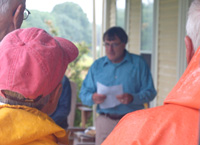The Wrack
The Wrack is the Wells Reserve blog, our collective logbook on the web.
The Wrack is the Wells Reserve blog, our collective logbook on the web.
 At this nationally recognized historic site that serves as a center for our activities, we are a great example of change and adaptation. We reveal so well that as our society changes — our economies, our values — so do the places we inhabit. Thus these 19th century buildings designed for farming have been adapted to serve our 21st century mission of coastal science, education, and stewardship.
At this nationally recognized historic site that serves as a center for our activities, we are a great example of change and adaptation. We reveal so well that as our society changes — our economies, our values — so do the places we inhabit. Thus these 19th century buildings designed for farming have been adapted to serve our 21st century mission of coastal science, education, and stewardship.
I have always felt our Reserve, located on the south coast of Maine, is a great example of the meeting of the past and the present — of natural ecosystems and cultural landscapes. They exist side-by-side, but are also interwoven. This place also illustrates for us that landscapes continually change; they are never stagnant. Natural systems and human actions change what we see around us — whether it is our contemporary efforts to keep our fields from reverting to forests through mowing or burning, or the natural forces of rivers and coastal currents that alter the shape and contours of our beaches. Change happens.
This is the theme of our new exhibits: “The Changing Landscape.” As our visitors will learn, this change can be massive and occur incrementally over thousands of years through the forces of the earth and climate, or over short time scales by earth-moving equipment or storm events. Because we are a public as well as a natural place, a common thread is woven throughout our exhibits: People. We are not apart from, but integral to, landscapes and landscape change. There is an interdependence between humans and the environment. And we have the ability to alter the world around us in significant ways.
To quote Environmental Historian William Cronon, whose writings served as a reference and an inspiration for these exhibits: “Different peoples choose different ways of interacting with their surrounding environments, and their choices ramify through not only the human community but the larger ecosystems as well.”
When we designed the exhibits we knew we needed to illustrate for visitors what occurs on the land. But we also realized that the interior of this old house is an important part of the story. So when we designed the exhibits we made sure we left exposed many of its beautiful features. The medium, in other words, is part of the message.
We hope the thousands of people who enjoy the exhibits in the years to come learn about change and adaptation, and how they have an important role to play in this never-ending process.
These remarks were made prior to the ribbon-cutting for the Changing Landscapes exhibit in the morning of June 25, 2011.